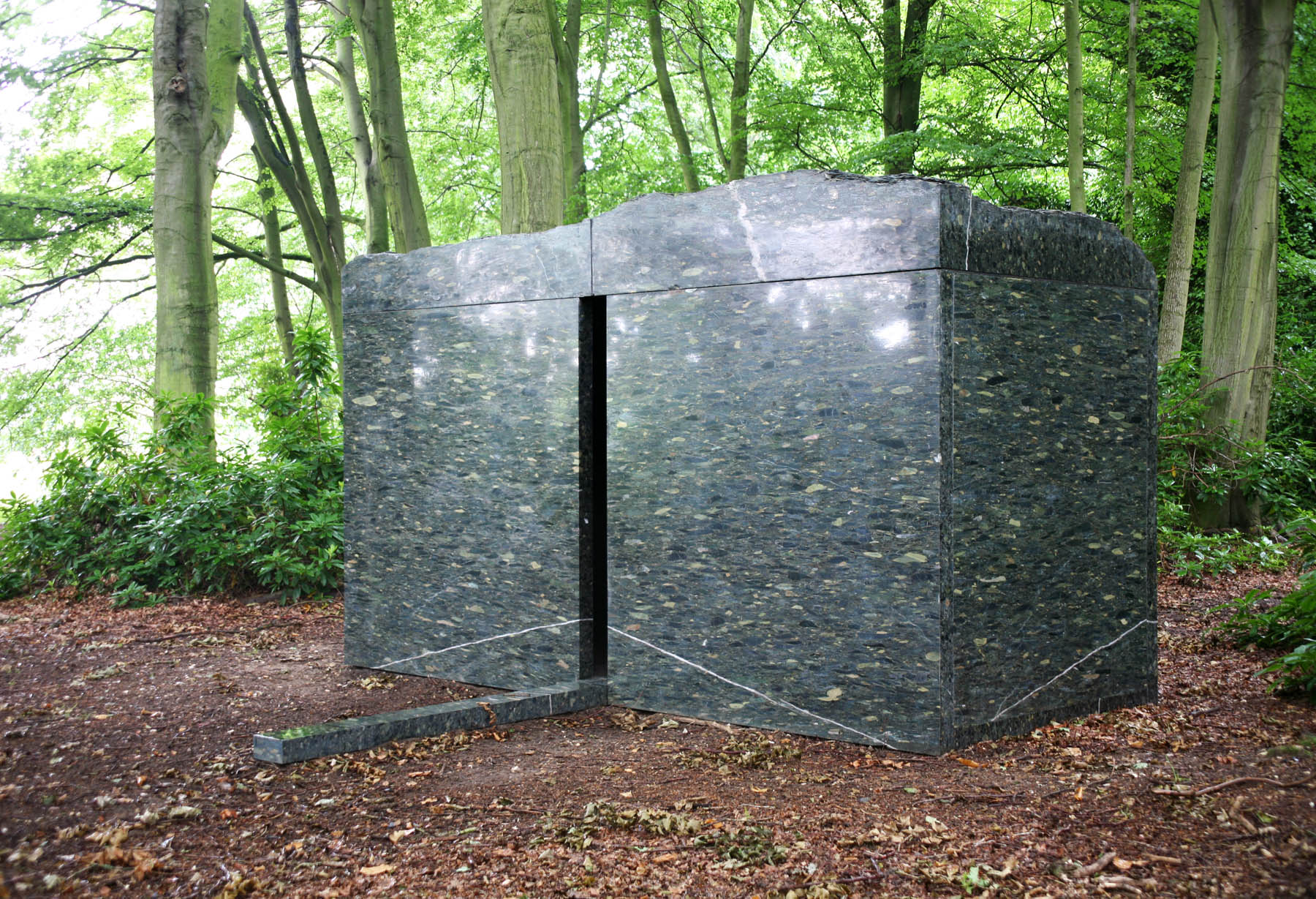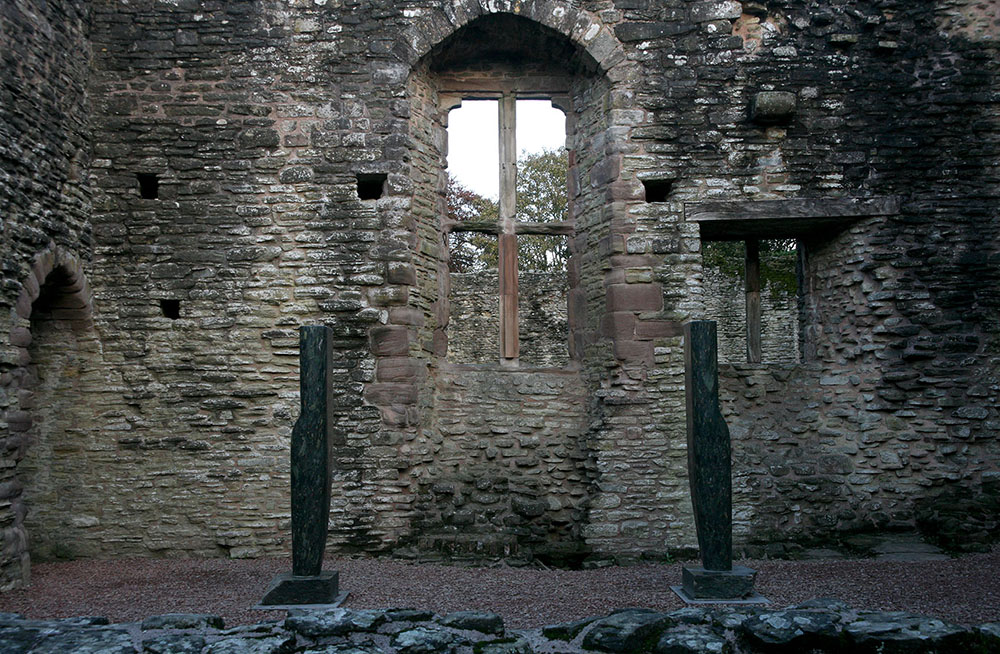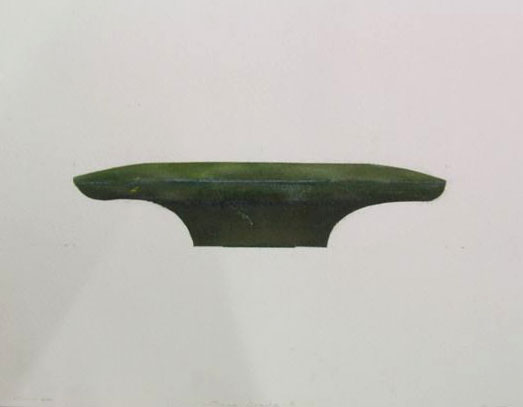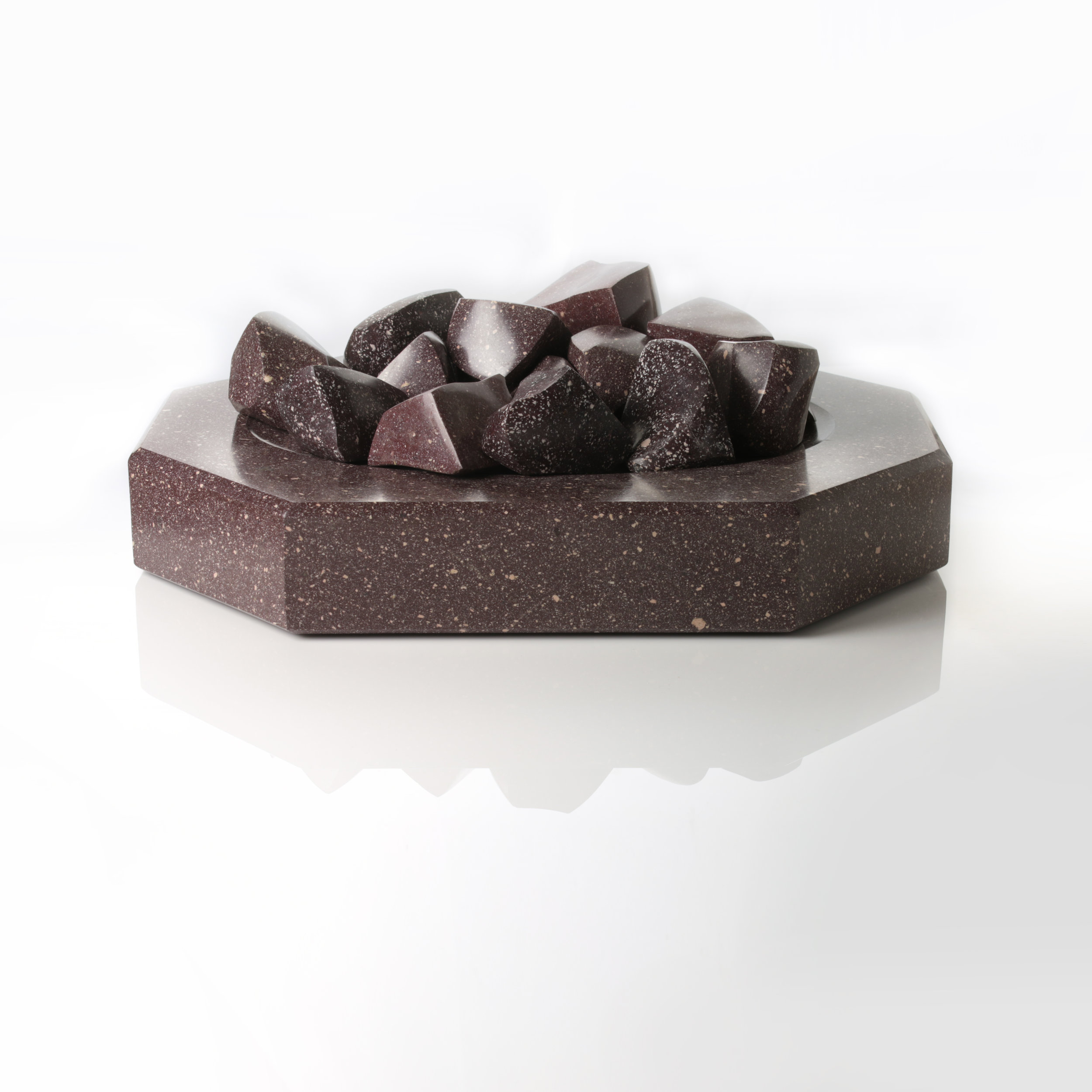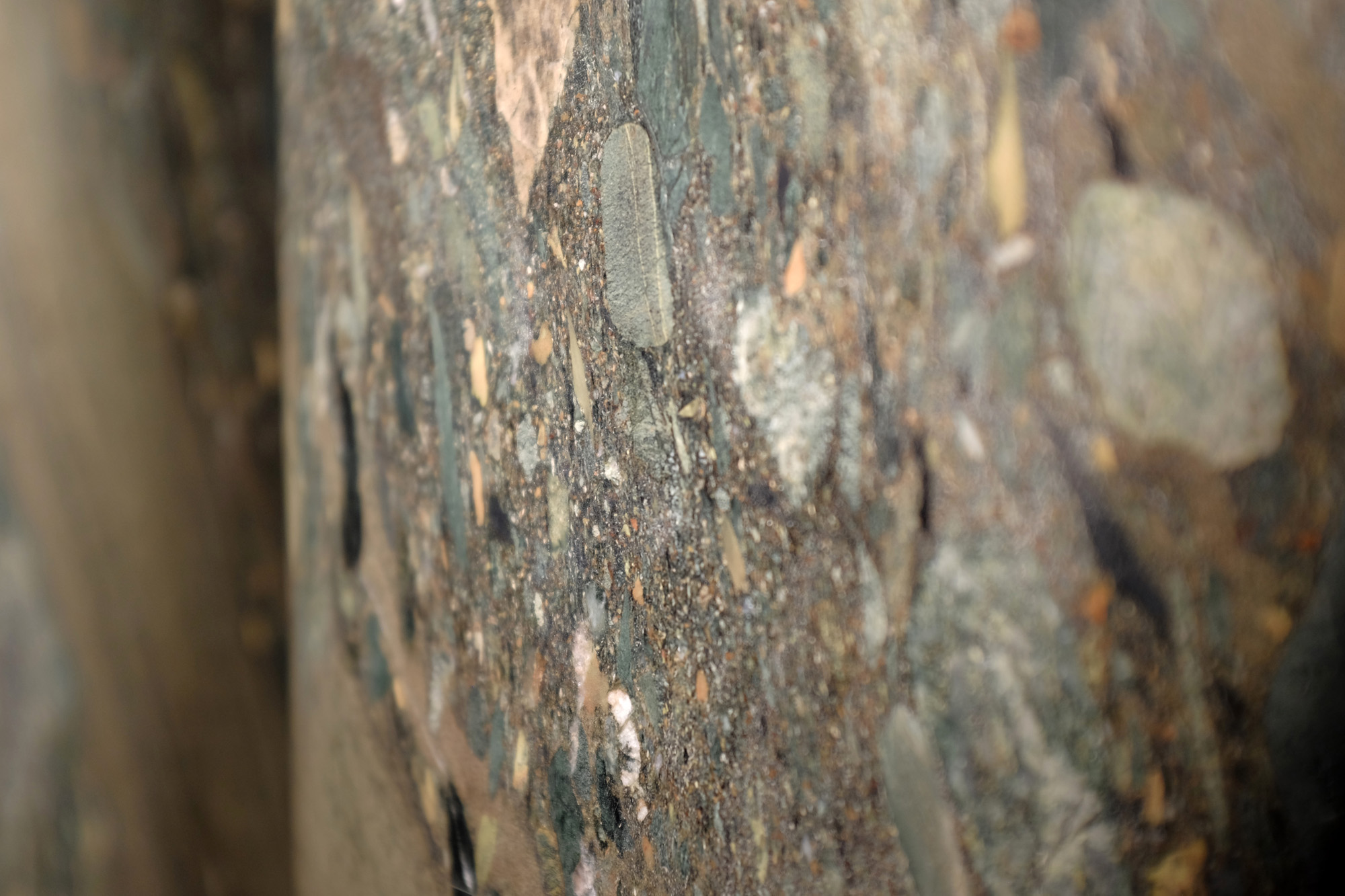
Interior Space, 1995
Interior Space, 1995
Carved Egyptian breccia
Houghton Hall, Norfolk
This sculpture was commissioned by the Henry Moore Foundation for the exhibition Stephen Cox: Surfaces and Stones of Egypt at the Henry Moore Institute, Leeds in 1995.
Interior Space was made in Egypt with stone procured from the desert of the Eastern Mountains near the site of the ancient gold mines and stone quarries of Waddi Hammamat. These quarries and mines are registered in the World’s oldest geological map which is in the Egyptian Museum in Turin and date from the time of Pepi III. The quarries there evidence its use with graffiti scratched into the walls of the Wadi (valley) dating back to Pre Dynastic times around 3,500 BC with later visits there from as far afield as Persia from where Darius the Great and Xerxes sent expeditions for this famous stone.
This fourteen ton sculpture is constructed but references the sheer scale of the monolithic sarcophagi of the Apis Bulls at Sakkara larger than any carved out for even the greatest Pharaoh.
The imaginative conceptions of the ‘afterlife’ of the peoples of ancient civilizations is the driver of the series of Interior Spaces that Cox has produced since 1995.
This the first of the Interior Spaces was exhibited after the Henry Moore Institute in the centre of the Central Hall at the Royal Academy Summer Exhibition in 1996, Stephen Cox at The Dulwich Picture Gallery 1997 and British Sculpture at Schloss Ambras, Innsbruck 1998-9. It was purchased by Lord Chalmondely for Houghton Hall in 2000.
Also at Houghton Hall:
Flask II, 2002
Hand-carved Egyptian breccia
Tribute to Sir John Soane, 1997
Tribute to Sir John Soane, 1997
Imperial porphyry
height: 25.00 cm, width: 38.00 cm, depth: 38.00 cm
The Government Art Collection, British Ambassadors Residence, Cairo
Capriccio: Olivier, 1998
Egyptian Alabaster
This piece was shown as a part of an exhibition at Glyndebourne Opera house:
Dreadnought: Problems of History, the Search for the Hidden Stone, 2003 - ongoing
Dreadnought: Problems of History, the Search for the Hidden Stone, 2003 - ongoing
Brecciated Imperial porphyry, 1 m x 2.7 m x 0.85 m
Installation photo at Chatsworth House
Installation photos in Bristol
Blade, 2003
Blade, 2003
Carved Egyptian porphyry
Height 9cm (3 1/2")
Width 30cm (11 3/4")
Depth 16cm (6 1/4")
This work is currently being shown by Adrian Sassoon, London.
This wonderful stone has a special place in my work since being given permission to extract stone from the Imperial quarries in Egypt nearly 30 years ago to make sculpture for the new Opera House in Cairo. With its transition from Roman Imperial exclusive use to its use after Constantine in Christian contexts, its symbolism is assured.
Gemini, 2004
Gemini, 2004
Loaned to Canterbury Cathedral from 2016-2017
These two figures are created from the same block of stone. As in a mirror the two pieces share the same characteristics.
From Waddi Hammamat in Upper Egypt between Qift in the Nile Valley and Al Quasayr on the Red Sea Coast, this conglomerate has been prized for longer than any other stone. The walls of the quarry testify to its having been used since pre dynastic times through the history of Egypt and so famed throughout the ancient World that Darius and Xerxes of Persia sent expeditions to procure it as did Philip of Macedonia, the father of Alexander the Great. Little used since antiquity, the quarry walls have wonderful ‘graffiti’ scratched into the rock faces showing popular gods and documenting the many expeditions from the past. The wadi (valley) was also ‘the fabled land of Koptos’ and the source of the Pharaoh’s gold. The stone is known variously as ‘Breccia Universale’, ‘Antique Egyptian’ or ‘Hammamat Breccia’ and Bekhen Stone that is a conglomerate cemented in a metagraywacke sandstone. It is strewn with bight coloured ‘pebbles’ and fragments of diverse stones :- granites, basalt, quartzes, schists, hornblende and hematite of red, yellow, black and pink in a greenish matrix with occasional white veins are why it has been prized for its beauty. These periods of activity have been recorded on the walls of the quarries with famous graffiti that has been left by the quarrymen. The graffiti consists of inventories of men and provisions that were tallied by the masters as well images of idols and offerings some simple, others technically very accomplished others primitive, expressing the yearnings of lonely men in a savage desert environment.
The Gemini series of sculpture deals with the relationship between two figures that share the family characteristics of the same block of stone and like the generative life force of a splitting cell. This is the first Gemini sculpture and was shown originally at ‘Sculpture in the Quad’ at Lincoln College Oxford where Cox was Montgomery Fellow in Sculpture 2009 followed by the Royal Academy Summer Exhibition in 2010 then The Meaning of Stone at Ludlow Castle in 2011.
At Canterbury Cathedral, in the new garden in the shadow of the Cathedral, the sculpture’s dualism symbolises the first life on earth with the splitting of the cell and of Adam and Eve.
This work was also displayed at Ludlow Castle in 2011 as a part of an exhibition called The Meaning of Stone - Images of this piece are below.
More works in Canterbury:
Hermaphrodite – Mappa Mundi, 2004
Hermaphrodite – Mappa Mundi, 2004
Carved Egyptian porphyry
Height 36.5cm (14 3/8")
Width 13.5cm (5 5/16")
Depth 9cm (3 1/2")
Interior Space: Blood of the Gazelle, 2005
Interior Space: Blood of the Gazelle, 2005
Red Egyptian granite
220x 400 x 200 cm
Exhibition Bristol City Museum and Art Gallery and City Sites
Private collection UK
Cruel Stones of St. Stephen, 2007
Cruel Stones of St. Stephen, 2007
Carved Egyptian porphyry
Height 16cm (6 1/4") Width 47cm (18 1/2") Depth 35cm (13 3/4")
This work is currently on show with Adrian Sassoon, London.
I stood outside a gate of Jerusalem at the spot where my namesake was stoned to death. The emotion was of horror of a world past and the use of porphyry appropriate to a commemoration of that moment.
Egyptian porphyry was exclusive in the Roman Imperial era and, after the conversion of Constantine, became symbolic of the Holy Blood of Christ and significant in church decoration through the Byzantine era. I have used Egyptian porphyry for a number of sculptures representing saints’ ‘attributes’; griddles dedicated to St Lawrence, the Sword of St George, and the Lance of St Thomas amongst others.
This sculpture dedicated to Stephen has added poignancy in a world where stoning to death is not an act of the distant past.
BekI, 2007, II, 2008 & Bek III, 2011
Bek I, 2007
Egyptian alabaster, 170 x 40 x 30 cm
Bek II, 2008
Egyptian alabaster, 153 cm x 36 cm x 24 cm
Bek III 2011
Egyptian brecciated alabaster, 178 cm x 39 cm x 24 cm
See all the works at this exhibition below:
Gemini III, 2012-16
Stephen Cox RA
Gemini III , 2012 - 2016
Carved Egyptian breccia
Gemini III is a sculpture consisting of a base and two abstract figures carved from the same block of stone. The stone is known variously as ‘antique Egyptian’ or ‘Hammamat breccia’ and is a conglomerate with bight coloured ‘pebbles’ and fragments of diverse stones: granites, marbles, quartzes, hornblende and hematite of yellow, red, black, pink and white strewn in a greenish matrix. It has been recognised for its beauty since pre-dynastic times making its source one of the oldest, if not the oldest, ‘decorative’ stone quarries in the world. Its fame has yielded up stone to expeditions sent by early kings and pharaohs of Egypt as well as from distant lands including Xerxes and Darius of Persia and Philip of Macedon father of Alexander. These periods of activity have been recorded on the walls of the quarries with famous graffiti that has been left by the quarrymen. The graffiti consists of inventories of men and provisions that were tallied by the masters as well images of idols and offerings some simple, others technically very accomplished others expressing the yearnings of lonely men in a savage desert environment.
The Gemini series of sculpture deals with the relationship between two figures that share the family characteristics of the same block of stone like the generative life force of a splitting cell mirroring the life force of the fertility god Min who was the supreme god of this fabled land of Koptos that was also the source of Egyptian gold. The first Gemini sculpture was shown originally at the Royal Academy Summer Exhibition followed by ‘The Meaning of Stone’ at Ludlow Castle and ‘Sculpture in the Quad’ at Lincoln College Oxford. It is currently on loan to Canterbury Cathedral until March 2017.
Peregrine: Sentinel, 2017
Peregrine: Sentinel, 2017
Hand-carved Egyptian porphyry set on an Egyptian porphyry base
Height 101cm (39 3/4")
Width 25.5cm (10")
Depth 24.5cm (9 5/8")
Interior Space: For Khafre, 2021
Aswan Granite 2.2m x 4.2m x 2m
For the Exhibition ‘Forever is Now’ curated by Art D’Egypte
The Pyramids Plateau, Giza, Egypt
“Forever Is Now” was an exhibition of contemporary art focused around international contemporary perspectives of ancient Egyptian civilization. It was held in 2021 at the Pyramids Plateau, Giza, Egypt.
It explored time as a continuum that divides and connects civilizations. Through blending rich cultural history and contemporary artwork it aimed to trace the continuity of ideas from the mythical past to the vibrant present, and to inspire the future of humanity.
Creation and installation images:



